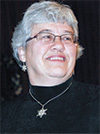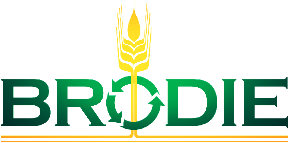At that time it was incorporated as Lakeside Dairy Ltd. Jeff joined the corporation in 2001 and moved up to president in 2007, a position he still holds.
Jeff’s sister, Stephanie, is expected to join within the next year. According to Jeff, she “has earned her way to participate on the ownership level.”
Dave and Jeff work side by side and cover for each other as necessary. They are responsible for the growing and marketing of crops and the composting of the dairy’s manure, as well as overall direction of the business.
Dan works on an hourly basis now, filling in as needed in any area of the enterprise and always on board for seeding and harvesting time.
Jeff’s mom, Wanda, helps with bill paying and she and Jeff’s wife, Coralee, share responsibility for providing meals. Coralee takes care of the bookkeeping in addition to caring for the couple’s two young children, Lily, 5, and Luke, 2. She also works off-farm as a public health nurse.
Four full-time workers are employed, three with the dairy and one with grain production. Jeff considers them to be “very valuable to the organization” and gives them credit for helping to keep things operating smoothly. His goal is to have long-term, committed employees and is well on his way to accomplishing this.
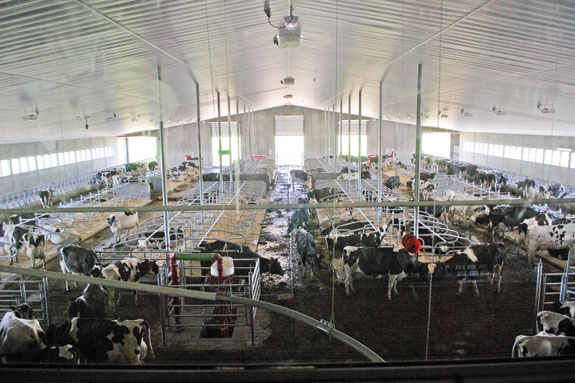
The family farms 2,500 acres of arable land. Cash crops utilize 1,800 acres for canola, wheat and barley, and seed potatoes use a further 170 acres. The balance of the acreage is used for forage, hay and silage.
The dairy herd consists of 170 to 180 cows, all purebred Holsteins, with commercial production being the primary goal. “(We) don’t breed for show; (we) breed for production and longevity,” Jeff claims.
The operation makes use of various tools like type classification and Dairy Herd Improvement (DHI) – important tools for breeding decisions and for improving production.
These decisions are the responsibility of herd manager Tony, who is “way ahead on that stuff,” Jeff says.
Breeding is done through various companies, making use of the top sires available to them. Mating program genomics are used. Replacements are 100 percent their own heifers. The farm also supplies some replacements to other herds.
Cows are housed in freestalls and milked with DeLaval robotic milkers.
Feeding is done in bunks with a goal of zero bunk refusals, accomplished by use of top-quality feeds. Dry matter intake averages approximately 60 pounds per day per cow.
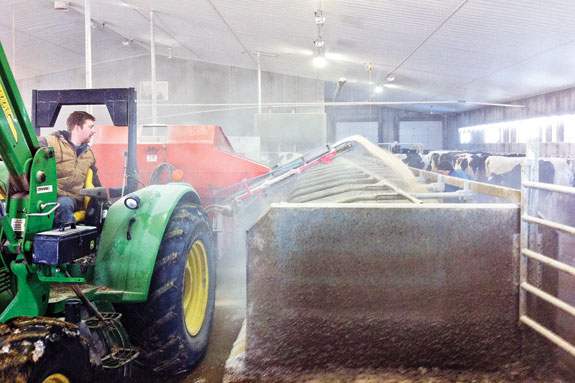
Manure composting
“I’m extremely excited about it,” Jeff says enthusiastically when asked about the farm’s method of composting the dairy’s manure production to become fertiliser.
Freestalls are bedded using a mix of phosphogypsum (PG), ground drywall and wood shavings. This makes a dry and very dense bedding material, giving the advantage of keeping cow stalls drier.
It is more absorbent than traditional bedding materials and lasts longer. The Nonays find it necessary to bed stalls every four to five weeks.
Phosphogypsum is a byproduct of phosphorus fertiliser production. Phosphate rock is mixed with sulphuric acid to release the phosphorus.
The remaining solids, mixed with water, become phosphogypsum. This substance contains high levels of calcium and sulphur, both desirable as soil nutrients.
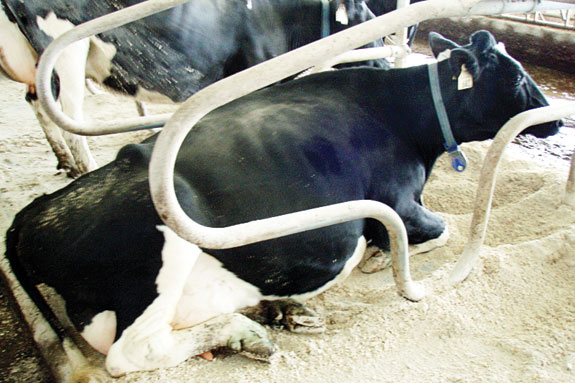
Nonay stockpiles scrap wallboard, which he obtains from a contractor friend. This creates an environmental benefit, as it would otherwise be dumped in a landfill.
The wallboard is set up in rows, to which are added cow manure, chicken manure and sometimes straw. Liquid manure is added if the piles are too dry.
The piles are started in the spring, following barn cleanout, and composted for several months. Nonay hires a commercial turner about every two weeks, four to six times over the course of the summer.
He is able to start spreading the composted fertiliser after about four months. Other than the cost of hiring the turner, he has a zero capital investment in this venture.
He ends up with 4,000 tons of finished compost after starting with more than 10,000 tons of feedstock. He is able to cover 1,000 acres every other year, so the entire farm benefits from this procedure.
At this time none of the fertiliser is for sale. “Too valuable to let it go,” Jeff says.
He expects to see long-term benefits from this method. He explains that the sulphur reacts with nitrogen, which reduces greenhouse gas emissions, and more nitrogen is retained to go to the soil.
Calcium, contained in gypsum, is the biggest macronutrient after nitrogen. The mixture binds clay particles with organic matter. The soil also accepts more water (acts like a sponge), improving the texture of the soil and resulting in greener, lusher alfalfa and other crops.
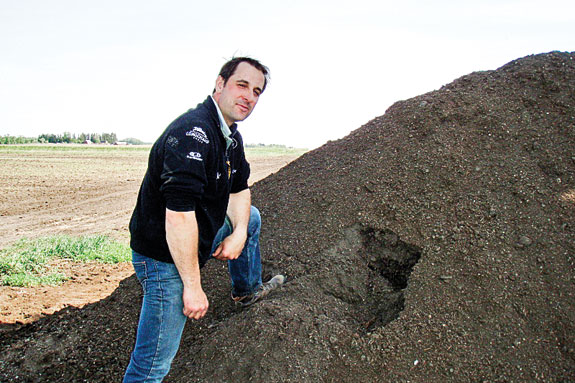
Jeff says that composting his manure cuts fertiliser expenses by about 80 percent and is, along with the dairy, the “most predictable part of my business.”
As president of the corporation, Jeff tries to keep abreast of everything. He checks in by phone or computer regularly, even when away from the farm.
All family members and employees are able to have time off, planned, if possible, so that only one or two people are off at any one time. When necessary, students are hired to help fill gaps.
In addition to his duties on the farm, Jeff is a delegate with Alberta Milk. He admits it takes a lot of his time but he enjoys speaking and sharing ideas.
For recreation, he plays hockey on a men’s team in Edmonton. His highest priority, though, is family, he says. PD
PHOTOS:
FIRST: Jeff Nonay stands in the middle of a pile of wallboard he’s collected. This is ground for bedding as well as churned into the farm’s manure compost piles.
SECOND: Freestalls are bedded using a mix of phosphogypsum (PG), ground drywall and wood shavings. This makes a dry and very dense bedding material, giving the advantage of keeping cow stalls drier.
THIRD: Farm employees, David and Tony, deliver gypsum/shavings bedding into the freestalls. Because the bedding is very absorbent, they find it necessary to bed stalls every four to five weeks.
FOURTH: Cows bedded in freestalls.
FIFTH: After several months of composting, the wallboard mixed with cow manure, chicken manure and sometimes straw becomes a valuable commodity for land application. Photos courtesy of Jeff Nonay.

Alice Guthrie
Freelance Writer

